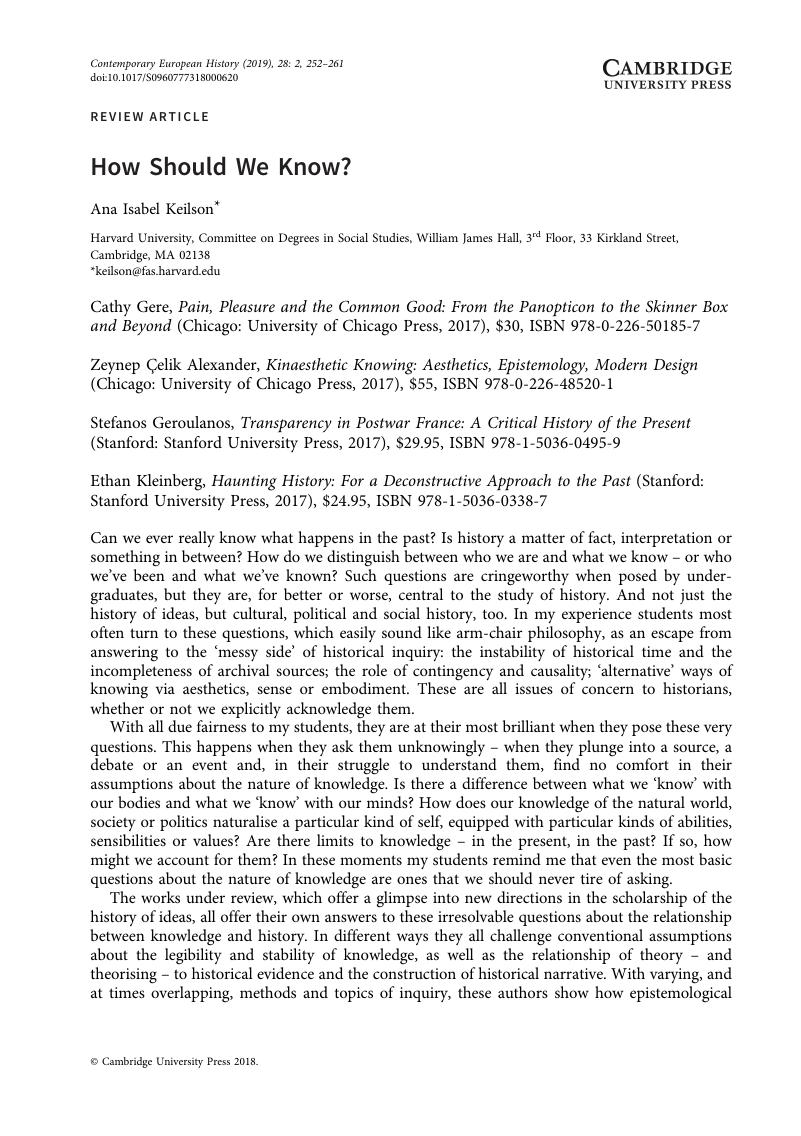No CrossRef data available.
Article contents
How Should We Know?
Review products
Published online by Cambridge University Press: 21 December 2018
Abstract

- Type
- Review Article
- Information
- Copyright
- © Cambridge University Press 2018
References
1 Schorske, Carl, Fin-de-Siècle Vienna: Politics and Culture (New York: Vintage Books, 1981), xvii Google Scholar.
2 Vidler, Anthony, The Architectural Uncanny (Cambridge, MA: MIT Press, 1992)Google Scholar. Cited in Geroulanos, Stefanos, Transparency in Postwar France: A Critical History of the Present (Stanford: Stanford University Press, 2017), 16 Google Scholar.
3 In particular, Shapin, Steve and Schaffer, Simon, Leviathan and the Air Pump (New Jersey: Princeton University Press, 1985)Google Scholar; Skinner, Quentin, Visions of Politics: Hobbes and Civil Science (Cambridge: Cambridge University Press, 2002)Google Scholar.
4 See, for example, Bennett, Jane, Vibrant Matter: A Political Ecology of Things (Durham, NC: Duke University Press, 2010)Google Scholar; Harman, Graham, Immaterialism (Cambridge: Polity, 2016)Google Scholar; Morton, Timothy, Hyperobjects: Philosophy and Ecology after the End of the World (Minneapolis, MN: Minnesota University Press, 2013)Google Scholar; Morton, , Realist Magic: Objects, Ontology, Causality (New Metaphysics) (n.p.: Open Humanities Press, 2013)CrossRefGoogle Scholar. For a useful response to Morton addressing the relationship of human sense perception to issues concerning environmental scale, see Coen, Deborah R., ‘Big is a Thing of the Past: Climate Change and Methodology in the History of Ideas’, Journal of the History of Ideas, 77, 2 (2016)CrossRefGoogle Scholar.
5 See, for example, Hunter, Matthew C., Wicked Intelligence: Visual Art and the Science of Experiment in Restoration London (Chicago: Chicago University Press, 2013)CrossRefGoogle Scholar; Scott, Joan, ‘The Evidence of Experience’, in James Chandler, Arnold I. Davidson and Harry Harootunian, eds., Questions of Evidence: Proof, Practice, and Persuasion Across the Disciplines (Chicago: University of Chicago Press, 1994)Google Scholar; Otto Sibum, Heinz, ‘Working Experiments: A History of Gestural Knowledge’, Cambridge Review, 116, 225 (1995)Google Scholar; Smith, Pamela, The Body of the Artisan: Art and Experience in the Scientific Revolution (Chicago: University of Chicago Press, 2004)CrossRefGoogle Scholar.
6 For the former, see Allesch, Christian G., Einführung in die psychologischen Ästhetik (Vienna: WUV, 2006)Google Scholar; Crary, Jonathan, Techniques of the Observer: On Vision and Modernity in the Nineteenth Century (Cambridge, MA: MIT Press, 1990)Google Scholar; Jarzombek, Mark, The Psychologizing of Modernity: Art, Architecture, and History (Cambridge: Cambridge University Press, 2000)Google Scholar; Podoro, Micahel, The Manifold in Perception: Theories of Art from Kant to Hildebrand (Oxford: Oxford University Press, 1972)Google Scholar. For examples of the latter, and in particular, histories of the concept of Bildung, see Marchand, Suzanne, Down from Olympus: Archaeology and Philhellenism in Germany 1750–1950 (Princeton, NJ: Princeton University Press, 1996)Google Scholar; Ringer, Fritz, ‘Bildung and its Implications in the German Tradition, 1890–1930’, in Fritz K. Ringer, Toward a Social History of Knowledge: Collected Essays (New York: Berghahn, 2000)Google Scholar.
7 Geroulanos, Stefanos, An Atheism That is Not Humanist Emerges in French Thought (Stanford: Stanford University Press, 2010)Google Scholar.
8 Canguilhem, Georges, Writings on Medicine, trans. and intro. Stefanos Geroulanos and Todd Meyers (New York: Fordham University Press, 2012)Google Scholar; Canguilhem, Georges, Knowledge of Life, trans. Stefanos Geroulanos and Daniela Ginsburg (New York: Fordham University Press, 2008)Google Scholar.
9 As examples of the former, see Christie, D. A. and Tansey, E. M., ‘Making the Human Body Transparent: The Impact of Nuclear Magnetic Resonance and Magnetic Resonance Imaging’, in E. M. Tansey, D. A Christie and L. A. Reynolds, eds., Wellcome Witnesses to Twentieth Century Medicine (London: Wellcome Trust, 1998)Google Scholar; Han, Byung-Chul, Tranzparenzgesellschaft (Berlin: Matthes & Seitz, 2013)Google Scholar. For the latter, see Butler, Judith, Gender Trouble (New York: Routledge, 1990)Google Scholar; idem , Giving an Account of Oneself (New York: Fordham University Press, 2005)Google Scholar.
10 See, for example, Baring, Edward, The Young Derrida and French Philosophy (Cambridge: Cambridge University Press, 2012)Google Scholar; Moyn, Samuel, Origins of the Other (Ithaca, NY: Cornell University Press, 2005)Google Scholar; Robcis, Camille, The Law of Kinship: Anthropology, Psychoanalysis, and the Family in France (Ithaca, NY: Cornell University Press, 2013)CrossRefGoogle Scholar; Sirkus, Judith, Sexing the Citizen: Masculinity and Morality in France, 1870–1920 (Ithaca, NY: Cornell University Press, 2006)Google Scholar. For other recent work in modern European intellectual history, see MacMahon, Darrin M. and Moyn, Sam, eds., Rethinking Modern European Intellectual History (Oxford: Oxford University Press, 2014)CrossRefGoogle Scholar.
11 Ethan Kleinberg, Joan Wallach Scott and Gary Wilder, ‘Theses on Theory and History’, May 2018. See http://theoryrevolt.com/ (last visited 16 June 2018).
12 Geertz, Clifford, ‘Thick Description: Toward an Interpretive Theory of Culture’, in Clifford Geertz, The Interpretation of Cultures: Selected Essays (New York: Basic Books, 1973), 25 Google Scholar.


